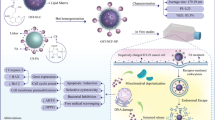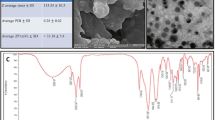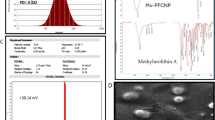Abstract
Oxypeucedanin (OPD) as a powerful anti-proliferative agent found in the Angelicae dahuricae has been used to suppress cancer cell growth. However, the hydrophobic chemical structure has limited its solubility and bio-accessibility. This is the first time OPD is encapsulated into a nano-liposomal structure and coated with poly-cationic chitosan polymer as the oxypeucedanin drug delivery system to evaluate its antioxidant and anti-colon cancer potential. The chitosan-coated oxypeucedanin nano-chitosomes (COPD-NCs) were synthesized utilizing the thin-layer hydration method and characterized by FESEM, DLS, FTIR, and zeta potential analysis. The anti-cancer potential of COPD-NC was analyzed by measuring the cell survival rate (MTT assay) and studying the cellular death type (AO/PI staining) following the increased treatment concentrations of COPD-NC on the HT-29 colon cancer cell line. Moreover, the COPD-NCs’ apoptotic activity was verified by analyzing Cas-3 and Cas-9 gene expression profiles. Finally, the COPD-NCs’ antioxidant activity was evaluated by applying ABTS, DPPH, and FRAP antioxidant assays. The 258.26-nm COPD-NCs significantly inhibited the HT-29 colon cancer cells compared with the normal fibroblast HFF cells. The up-regulated Cas-3 and Cas-9 gene expression exhibited the COPD-NCs’ apoptotic activity. Also, the COPD-NCs’ apoptotic activity was verified by detecting the increased apoptotic bodies following the AO/PI fluorescent staining in the increased exposure doses of COPD-NCs. Ultimately, the COPD-NCs meaningfully inhibited the ABTS-DPPH radicals and exhibited an appropriate FRAP-reductive potential. The designed nanostructure for COPD-NCs significantly improved its antioxidant potential and selective cytotoxicity on human HT-29 human cancer cells, which makes them a safe selective natural drug delivery system. Therefore, the COPD-NCs can selectively induce apoptotic death in human HT-29 cancer cells and have the potential to be studied as an anti-colon cancer compound. However, further cancer and normal cell lines are required to verify their selective cytotoxicity.







Similar content being viewed by others
Data availability
The datasets used and/or analyzed during the current study are available from the corresponding author upon reasonable request.
References
Aggarwal V et al (2020) Molecular mechanisms of action of hesperidin in cancer: recent trends and advancements. Exp Biol Med 245(5):486–497
Al-Shammari AM et al (2020) Galangin enhances gold nanoparticles as anti-tumor agents against ovarian cancer cells. in AIP Conference Proceedings. AIP Publishing
Al-Ziaydi AG et al (2020) Hexokinase inhibition using D-mannoheptulose enhances oncolytic Newcastle disease virus-mediated killing of breast cancer cells. Cancer Cell Int 20(1):1–10
Antolovic D et al (2010) Heterogeneous detection of circulating tumor cells in patients with colorectal cancer by immunomagnetic enrichment using different EpCAM-specific antibodies. BMC Biotechnol 10:1–8
Asgharian P et al (2022) Potential mechanisms of quercetin in cancer prevention: focus on cellular and molecular targets. Cancer Cell Int 22(1):257
Bakirdere EG et al (2016) Design, synthesis, characterization and antibacterial and antifungal activity of a new 2-{(E)-[(4-aminophenyl)imino]-methyl}-4,6-dichlorophenol and its complexes with Co(II), Ni(II), Cu(II) and Zn(II): an experimental and DFT study. J Serb Chem Soc 81(5):12
Beyrami M et al (2020) Synthesized chrysin-loaded nanoliposomes improves cadmium-induced toxicity in mice 27(32):40643-40651
Bray F et al (2018) Global cancer statistics 2018: GLOBOCAN estimates of incidence and mortality worldwide for 36 cancers in 185 countries. CA Cancer J Clin 68(6):394–424
Brentnall M et al (2013) Caspase-9, caspase-3 and caspase-7 have distinct roles during intrinsic apoptosis. BMC Cell Biol 14:1–9
Chakraborti S, Ray BK, Roychoudhury S (2020) Handbook of oxidative stress in cancer: mechanistic aspects. Springer
Delkhah AMD, Karimi E, Farivar S (2023) Herniarin-loaded solid lipid nanoparticles: promising molecular mechanism and therapeutic potential against pancreatic cancer line 1–11
Efferth T (2005) Mechanistic perspectives for 1, 2, 4-trioxanes in anti-cancer therapy. Drug Resist Updates 8(1–2):85–97
Farhadi A et al (2023) Targeted delivery and anticancer effects of chrysin-loaded chitosan-folic acid coated solid lipid nanoparticles in pancreatic malignant cells. J Biomater Sci Polym Ed 34(3):315–333
Feng T et al (2017) Liposomal curcumin and its application in cancer. Int J Nanomed 12:6027
Goel A, Boland CR, Chauhan DP (2001) Specific inhibition of cyclooxygenase-2 (COX-2) expression by dietary curcumin in HT-29 human colon cancer cells. Cancer Lett 172(2):111–118
Gulbake A et al (2016) Insight to drug delivery aspects for colorectal cancer. World J Gastroenterol 22(2):582
Güneş Bayır A (2021) Handbook of oxidative stress in cancer: mechanistic aspects
Haeri V et al (2023) Synthesized nanoliposome‐encapsulated kaempferol attenuates liver health parameters and gene expression in mice challenged by cadmium‐induced toxicity 70(1):429-438
Homayouni-Tabrizi M et al (2018) Silver–palm pollen nanocomposite exhibits antiproliferative, antioxidant, and proapoptotic properties on MCF-7 breast cancer cells. Res Chem Intermed 44:6537–6548
Homayouni-Tabrizi M et al (2019) Putative mechanism for anticancer properties of Ag–PP (NPs) extract. IET Nanobiotechnol 13(6):617–620
Hussar P (2022) Apoptosis regulators Bcl-2 and caspase-3. Encyclopedia 2(4):1624–1636
Ibrahim AA et al (2021) Pt (II)-thiocarbohydrazone complex as cytotoxic agent and apoptosis inducer in Caov-3 and HT-29 Cells through the P53 and caspase-8 pathways. Pharmaceuticals 14(6):509
Islam MT et al (2019) Anticancer activity of thymol: a literature-based review and docking study with emphasis on its anticancer mechanisms. IUBMB Life 71(1):9–19
Jabir MS, Taha AA, Sahib UI (2018) Linalool loaded on glutathione-modified gold nanoparticles: a drug delivery system for a successful antimicrobial therapy. Artif Cells Nanomed Biotechnol 46(sup2):345–355
Jabir MS et al (2018) Porous silicon nanoparticles prepared via an improved method: a developing strategy for a successful antimicrobial agent against Escherichia coli and Staphylococcus aureus. in IOP Conference Series: Materials Science and Engineering. IOP Publishing
Jafari-Moghaddam F et al (2018) Three VO2+ complexes of the pyridoxal-derived Schiff bases: synthesis, experimental and theoretical characterizations, and catalytic activity in a cyclocondensation reaction. J Mol Struct 1153:149–156
Jahanafrooz Z et al (2020) Colon cancer therapy by focusing on colon cancer stem cells and their tumor microenvironment. J Cell Physiol 235(5):4153–4166
Jasim AJ et al (2022) Preliminary trials of the gold nanoparticles conjugated chrysin: an assessment of anti-oxidant, anti-microbial, and in vitro cytotoxic activities of a nanoformulated flavonoid. Nanotechnol Rev 11(1):2726–2741
Khatamian N et al (2022) Pinus morrisonicola needles essential oil nanoemulsions as a novel strong antioxidant and anticancer agent. Inorg Nano-Metal Chem 52(2):253–261
Kuligowski J et al (2008) On-line gel permeation chromatography–attenuated total reflectance–Fourier transform infrared determination of lecithin and soybean oil in dietary supplements. J Chromatogr A 1185(1):71–77
Memari F et al (2022) Tumor-inhibitory effects of zerumbone against HT-29 human colorectal cancer cells. Int J Toxicol 10915818221104417
Moeini S, Karimi E, Oskoueian E (2022) Antiproliferation effects of nanophytosome-loaded phenolic compounds from fruit of Juniperus polycarpos against breast cancer in mice model: synthesis, characterization and therapeutic effects. 13(1):20
Mottaghipisheh J (2021) Oxypeucedanin: chemotaxonomy, isolation, and bioactivities. Plants 10(8):1577
Namvar F et al (2016) Nanosized silver–palm pollen nanocomposite, green synthesis, characterization and antimicrobial activity. Res Chem Intermed 42:1571–1581
Ozkan G et al (2023) A mechanistic updated overview on lycopene as potential anticancer agent. Biomed Pharmacother 161:114428
Park SH et al (2020) The Antiproliferative activity of oxypeucedanin via induction of G2/M phase cell cycle arrest and p53-dependent MDM2/p21 expression in human hepatoma cells. Molecules 25(3):501
Rahmani F, Karimi E, Oskoueian E (2020) Synthesis and characterisation of chitosan-encapsulated genistein: its anti-proliferative and anti-angiogenic activities. 37(4):305–313
Rashid TM et al (2021) Synthesis and characterization of Au: ZnO (core: shell) nanoparticles via laser ablation. Optik 244:167569
Sadeghi S, Homayouni Tabrizi M, Farhadi A (2023) Folic acid-chitosan coated stylosin nanostructured lipid carriers: fabrication, in vitro–in vivo assessment in breast malignant cells. J Biomater Sci Polym Ed 34(6):791–809
Salopek B, Krasic D, Filipovic S (1992) Measurement and application of zeta-potential. Rudarsko-Geolosko-Naftni Zbornik 4(1):147
Seyedi SMR, Asoodeh A, Darroudi M (2022) The human immune cell simulated anti-breast cancer nanorobot: the efficient, traceable, and dirigible anticancer bio-bot. Cancer Nanotechnol 13(1):1–24
Shahbazian S et al (2015) Anti-cancer activity of pegylated liposomal trans-anethole on breast cancer cell lines MCF-7 and T47D. Biotech Lett 37:1355–1359
Shehab NG et al (2011) Chemical constituents and biological activities of Fagonia indica Burm F. Res J Med Plant 5(5):531–546
Shoeibi A et al (2023) Enhancing healthcare outcomes and modulating apoptosis-and antioxidant-related genes through the nano-phytosomal delivery of phenolics extracted from Allium ampeloprasum 14(8):1547
Smith B (2016) Group wavenumbers and an introduction to the spectroscopy of benzene rings. Spectroscopy 31(3):34-37-34–37
Soltani M et al (2015) Transcriptional analysis of VEGF-D and TGFβ genes in MCF7 cells exposed to saponin isolated from Holothuria leucospilota (sea cucumber). Rep Biochem Mol Biol 4(1):25
Soltani M et al (2022) Incorporation of Boswellia sacra essential oil into chitosan/TPP nanoparticles towards improved therapeutic efficiency. Mater Technol 37(11):1703–1715
Stetefeld J, McKenna SA, Patel TR (2016) Dynamic light scattering: a practical guide and applications in biomedical sciences. Biophys Rev 8(4):409–427
Sung H et al (2021) Global cancer statistics 2020: GLOBOCAN estimates of incidence and mortality worldwide for 36 cancers in 185 countries. CA Cancer J Clin 71(3):209–249
Tabatabaeain SF, Karimi E, Hashemi M (2022) Satureja khuzistanica essential oil-loaded solid lipid nanoparticles modified with chitosan-folate: evaluation of encapsulation efficiency, cytotoxic and pro-apoptotic properties 10:904973
Taghavinia F et al (2022) Nanoliposome-loaded phenolics from Nasturtium officinale improves health parameters in a colorectal cancer mouse model 12(24):3492
Tomeh MA, Hadianamrei R, Zhao X (2019) A review of curcumin and its derivatives as anticancer agents. Int J Mol Sci 20(5):1033
Umar AK et al (2022) Liposome-polymer complex for drug delivery system and vaccine stabilization. Heliyon e08934
Veisi A et al (2020) Role of crocin in several cancer cell lines: an updated review. Iran J Basic Med Sci 23(1):3
Wang Y et al (2020) The anti-cancer mechanisms of berberine: a review. Cancer Manag Res 12:695
Wolfram J et al (2016) Hesperetin liposomes for cancer therapy. Curr Drug Deliv 13(5):711–719
Wu X et al (2016) A review of toxicity and mechanisms of individual and mixtures of heavy metals in the environment 23(9):8244-8259
Acknowledgements
This work was supported by the Islamic Azad University, Tehran, Iran, and therefore is appreciated by the author.
Funding
This research was performed at personal expense in the laboratory of Islamic Azad University of Tehran.
Author information
Authors and Affiliations
Contributions
Muntadher Aqeel Obaid Almohammed, Mahshid Sharbatiyan and Hasti Nasiraei Haghighi: Methodology, Investigation, Formal analysis, Software and Writing-Original draft. Sakineh Meshkani, Masoud Homayouni Tabrizi: Supervision, Data curation, Conceptualization, Validation and Writing- Reviewing. The authors declare that all data were generated in-house and that no paper mill was used.
Corresponding author
Ethics declarations
Ethics approval and consent to participate
All institutional and national guidelines for the care and use of laboratory animals were followed.
Consent for publication
Not applicable.
Competing interests
The authors declare no competing interests.
Additional information
Publisher's Note
Springer Nature remains neutral with regard to jurisdictional claims in published maps and institutional affiliations.
Rights and permissions
Springer Nature or its licensor (e.g. a society or other partner) holds exclusive rights to this article under a publishing agreement with the author(s) or other rightsholder(s); author self-archiving of the accepted manuscript version of this article is solely governed by the terms of such publishing agreement and applicable law.
About this article
Cite this article
Almohammed, M.A.O., Meshkani, S., Homayouni Tabrizi, M. et al. Anti-proliferative activity of chitosan-coated oxypeucedanin nano-chitosomes (COPD-NCs) against human HT-29 colon cancer cells: in vitro study. Naunyn-Schmiedeberg's Arch Pharmacol 397, 2133–2143 (2024). https://doi.org/10.1007/s00210-023-02748-3
Received:
Accepted:
Published:
Issue Date:
DOI: https://doi.org/10.1007/s00210-023-02748-3




